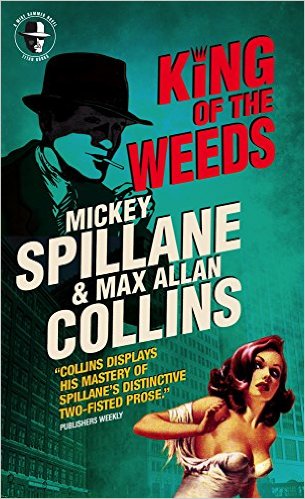A sentence that is as unlikely as it is true:
Better Call Saul is really giving Breaking Bad a run for its money in terms of quality.
The former is the prequel series of the latter, of course, focusing on the character of Saul Goodman, who was originally Jimmy McGill, a man who struggles to get respect from most people in his life. Vince Gilligan and Peter Gould have added a surprising amount of pathos to the character who was essentially the comic relief in Walter White’s tragic tale. Jimmy’s brother Chuck (played by the always fantastic Michael McKean) is a legal genius and will always see his little brother as the screwup he was in his twenties. Instead of playing in the major leagues like his brother, Jimmy must do his best to hang in the lowest levels of the legal profession in spite of the hard work he put in to overcome those problems.
The program is fantastic and worth a watch, but I have a nit to pick. One of the lessons I absorbed from the great Lee K. Abbott is to do as much as possible to avoid allowing a factual error to dissipate the spell that we cast over the reader. If you have a character use a ballpoint pen in 1934, people like me will no longer be immersed in your world. Why? Ballpoint pens didn’t reach the masses until at least a decade later. Instead of thinking about your story and your characters, I’m bringing up my mental encyclopedia.
I just had the same experience with “Cobbler,” the episode of Better Call Saul that debuted on February 22, 2016 and was written by Gennifer Hutchison and was directed by Terry McDonough. The episode is well-written and well-directed and well-acted. Of course, but there’s a lesson to be learned.
One of the subplots in “Cobbler” centers upon Mike Ehrmantraut, a “fixer,” trying to retrieve baseball cards that were stolen from his foolish former client, Daniel. Instead of keeping a low profile after selling prescription drugs to a gang, Daniel uses his new income to buy a gaudy yellow Hummer H2 that is painted up in gaudy hot pink flames, a color scheme so gaudy that even the 1980s would be embarrassed. And the spinners on the rims! Ugh.
Daniel foolishly declines Mike’s services, which results in his connection learning his home address. As you might expect, the drug dealer simply burgled Daniel’s house, stealing his remaining supply of pills and his extremely valuable baseball cards.
Now, I happen to be a bit of a baseball card collector; I certainly know my stuff about cards from the 1980s through the early 1990s, as that is when I was allowed to have little else on my mind but baseball and books. (Good times.) So Mike negotiates to get the cards back. Daniel said in the previous episode that he had some valuable rookies and some Mantle and Aaron cards…the kind of thing I’d expect to see if we’re talking valuable cards. Daniel said that the cards are in “top loaders,” which makes sense, though I would have expected that a well-heeled collector would have his cards slabbed by PSA or a similar service. But close enough.
Okay, so I’m watching the cool scene from “Cobbler.” Daniel is trading his gaudy Hummer for the cards. I am loving Mark Proksch’s great acting; how can Daniel not understand the very basics about criminal stuff? The baseball card fan in me sees the boxes…there are four monster boxes and a couple even larger boxes. Impressive!
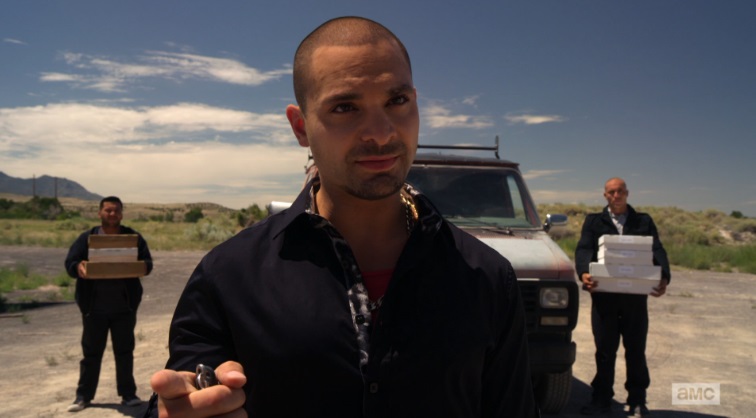
The henchmen put the cards in Mike’s trunk. Of course, Daniel double-checks to make sure everything is there. Me? I’m excited to see if he has an Al Kaline rookie or any beautiful 1956 Topps cards or maybe even some earlier Bowman stuff! What could be in there? Remember, these are extremely valuable cards that are worth enough money to drive a plot in a show about drug dealers and attorneys!!!
Daniel says, “Aaron…there’s Jeter…” The director cuts to an insert shot of Daniel flipping through the cards:

Wait. What? No. Just. No. That is NOT what a box of extremely valuable cards looks like. That’s what a box of commons looks like. None of the cards are in top loaders or in slabs. There are clearly stacks of cards from the same sets just slapped together in a hodgepodge. Even worse, these are clearly cards that are worth next to nothing. Look at the bottom right; there’s a few packs’ worth of 1988 Donruss cards. See? Look at the borders:
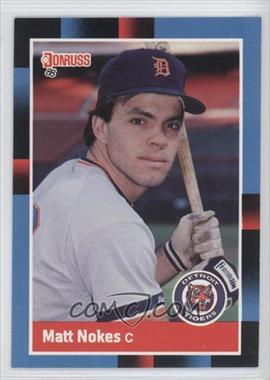 Even though Matt Nokes is my favorite player, the card is worth no more than a few cents. Certainly not enough to get Mike Ehrmantraut out of bed. And look at the card peeking out under Daniel’s left thumb. It’s a 1988 Topps football card:
Even though Matt Nokes is my favorite player, the card is worth no more than a few cents. Certainly not enough to get Mike Ehrmantraut out of bed. And look at the card peeking out under Daniel’s left thumb. It’s a 1988 Topps football card:
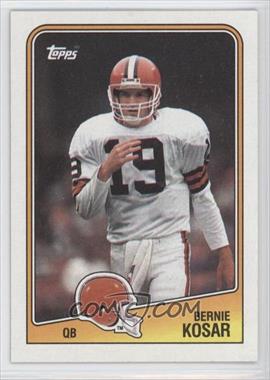
And it looks like the cards above the 1988 Donruss are from 1991 Fleer. Notice the maximum yellow:
 Here’s the problem. The production designer and the prop people and all of the other brilliant behind-the-scenes folks put together a show that makes me believe everything is real. I love being immersed into the seedy side of Albuquerque. These professionals even managed to find or make the perfect watch and shoes for Daniel’s character; the match the ugly paint scheme of the car and say a lot about his character.
Here’s the problem. The production designer and the prop people and all of the other brilliant behind-the-scenes folks put together a show that makes me believe everything is real. I love being immersed into the seedy side of Albuquerque. These professionals even managed to find or make the perfect watch and shoes for Daniel’s character; the match the ugly paint scheme of the car and say a lot about his character.
Look! Daniel even seems happy to get back a bunch of 1987 Topps. I love that set. It’s probably my favorite. But no drug dealer is going to steal your 1987 Topps cards in hopes of making money. You will not get any money for these cards. Topps printed about 11 trillion of them.
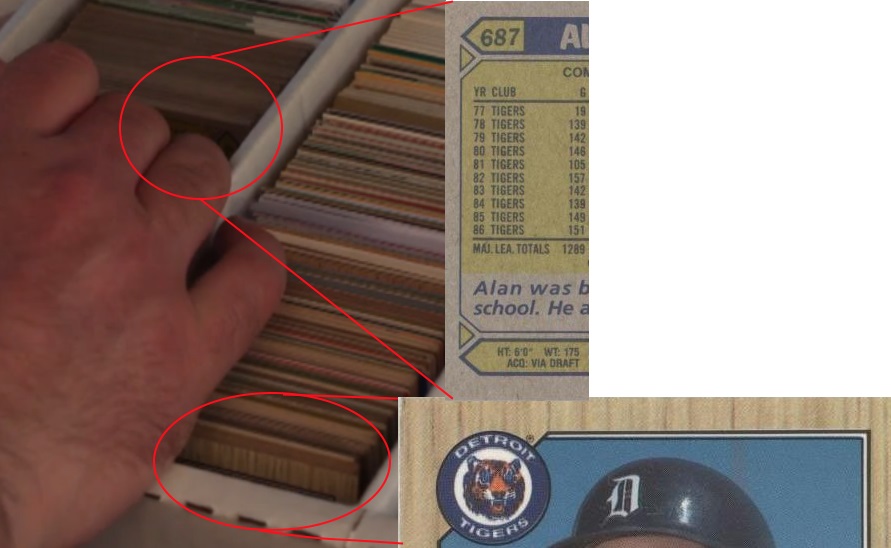
There are much graver sins that a writer can commit, but I think this is a good illustration of how we must make sure we are presenting the world as it is and was in our fiction. Instead of spending the past 45 minutes watching the episode of Better Call Saul and ruminating on how great the program is, I wrote this post.
I’m sure that Mr. Gilligan and Mr. Gould and Mr. McDonough and Ms. Hutchison would all agree with me that storytellers have many things in common with magicians. We cast very different incantations, but they are spells nonetheless. Let us do nothing to our audiences to make the effects of that spell fade.
Television Program
Better Call Saul, Gennifer Hutchison, Terry McDonough
Writers are asked many general questions about their craft.
…”What is your overarching philosophy regarding the inherent power of fiction?”…”What IS-character-to you?”…”What is the position of place in your work?”…
These are great and important questions, but I’m really curious about the little things. In the “Hey, Why’d You Do That” series, I ask accomplished writers about some of the very small choices they made during the process of composition.
I don’t happen to know Jan Bowman very well, but it is very clear that she is a very good literary citizen and a dedicated writer. She cares about the community, but more importantly, she cares about trying ever harder to improve her own work. In 2015, Evening Street Press published Flight Path & Other Stories. I’m sure you will enjoy Ms. Bowman’s insights into her own work; why not consider picking up a copy directly from the publisher?

Yes, you may wish to read 10,000 words in which Ms. Bowman describes the methods by which we can add depth to our characters. Instead, I am curious about the tiny choices that Ms. Bowman made when she wrote the title story of her collection. Let’s take a look at her way of thinking and see how it affects our own! (Don’t worry…I made sure that you’ll still get some use out of the interview if you haven’t read the story.)
Continue Reading
Short Story Collection
Evening Street Press, Jan Bowman
Close your eyes, if you will, and imagine a time when reading prose was the primary way that people consumed stories. (Then open your eyes or else you can’t read this essay.) There was no Law & Order, no NCIS, no NCIS: Dubuque, no NCIS: Portland (Maine). How did people satisfy their needs when they were jonesing for a mystery?
They read mystery books and stories! I know…American culture will never be the same as it was in the good old days in terms of respect for writers and prose, but there are still few pleasures as powerful as cracking open a paperback and sipping a hard-boiled mystery story like a glass of Johnny Walker neat.
In case you weren’t aware, Mickey Spillane is one of the best-selling authors of all time. He is most famous for the detective he created, Mike Hammer, a private dick who isn’t afraid to use some violence to take some scum off the streets. Mr. Spillane died in 2006 and left a number of manuscripts that he wanted completed by Max Allan Collins, a friend and similarly world-class crime novelist. (I love his Quarry series. Check it out.) One of these unfinished manuscripts was that of King of the Weeds, a novel whose events take place after those of Black Alley. Hard Case Crime/Titan Books is the publisher; they are one of my favorites because they produce great books at a great price and they are keeping the tradition of hard-boiled crime fiction alive.
Yes. I understand that writers such as Mr. Collins and Mr. Spillane will never be considered among the great literary lions. While both authors likely developed back problems from all of the laurels heaped upon them, hard-boiled crime thrillers are not the kind of books that many “literary” people want to glorify. I find this quite sad. Look how much we can learn from the first page of King of the Weeds:
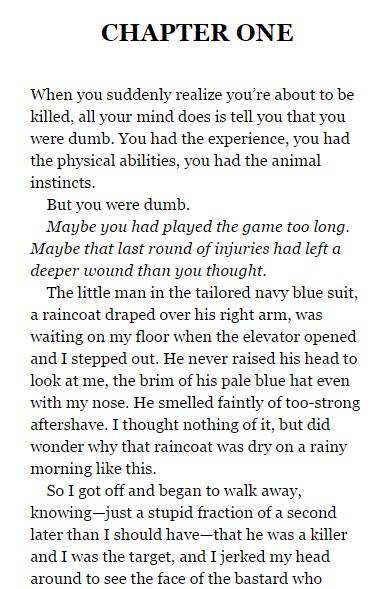
Let’s tally up all of the basic things that Mr. Spillane and Mr. Collins do in these first few paragraphs:
- Establish life-or-death stakes for the narrator
- Employ a little second-person to grab the reader before the first person takes effect
- Depict the hit man that will obviously figure into the narrative
- Remind the reader that Hammer is older than he was and perhaps a step slower, which ratchets up the threat
- Begin the novel in medias res with an attempted murder of the protagonist.
You want to read on, don’t you? Of course you do. I invite you to compare the first page of King of the Weeds to that of the average literary book. Does every book need to begin with an attempted murder? Of course not. But we all do well to introduce big stakes and to do so very early.
Mr. Spillane and Mr. Collins do a lot of great subtle things in this first page. I’ve marked up the image:
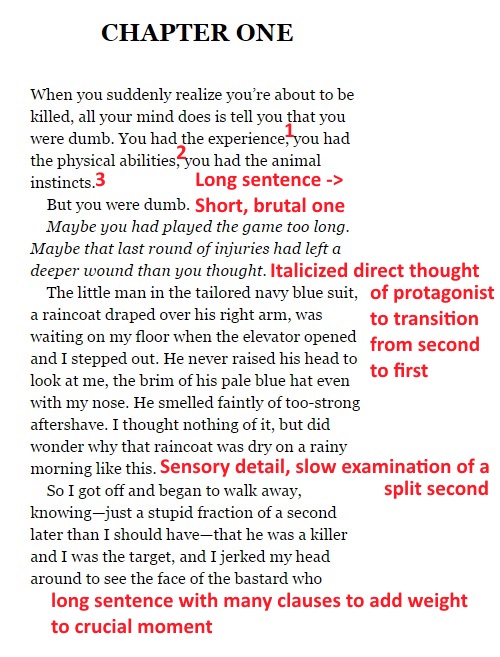 Mr. Spillane and Mr. Collins pull of some beautiful tricks with their prose here. In that first paragraph, they employ the rule of three, establishing a rhythm that carries the reader away-
Mr. Spillane and Mr. Collins pull of some beautiful tricks with their prose here. In that first paragraph, they employ the rule of three, establishing a rhythm that carries the reader away-
only to punch you in the gut with that four-word second sentence. The prose also reflects the rhythm of what Hammer is going through at the moment. His day is about to begin…everything is calm…everything is normal-
gunshot.
Mr. Spillane and Mr. Collins know that the second person “you” bit is a great way to open the book, but they also know that they can’t stay in the second person too long without confusing the reader. How do they ride the line, earning the punch of those first two paragraphs while gently easing the reader into the first person that rules the rest of the book? They use that italicized direct thought from Hammer as an adapter. Isn’t that clever?
I’m reminded of the opening of The Hunt for Red October. No one involved wanted the Russians in the film to speak Russian through the whole film. On the other hand, it always seems silly when people Sam Neill and Sean Connery speak Russian. We all know that neither of those guys speak Russian. But then we wonder why the Russians are speaking English with Scottish inflection. It’s a lose-lose all around. So the writer and director of The Hunt for Red October both acknowledge and work around the dilemma:
In that one quick moment, they say: LOOK. I KNOW YOU DON’T SPEAK RUSSIAN AND THAT YOU PROBABLY DON’T LIKE SUBTITLES. HERE’S THE DEAL. THE FIRST FEW MINUTES WERE IN RUSSIAN, BUT NOW? WE’RE SWITCHING. YOU’RE GOING TO GO WITH IT. OKAY? COOL.
Mr. Spillane and Mr. Collins use that italicized thought from Hammer in the same way to transition: WEREN’T THOSE FIRST TWO PARAGRAPHS COOL? WE KNOW, THANKS. THEY WOULDN’T HAVE BEEN AS COOL WITHOUT THE “YOU.” BUT HERE’S THE DEAL. THE REST OF THE BOOK IS IN FIRST PERSON FROM HAMMER’S PERSPECTIVE, SO LET THAT SINK IN AS YOU READ WHAT WE ARE POINTING OUT IS HAMMER’S FIRST BIT OF EXPLICIT NARRATION.
The fourth paragraph starts to take a little time. Mr. Spillane and Mr. Collins have Hammer walk into an early morning ambush that takes roughly two seconds in real time. That’s not going to work in a novel. Instead, the authors slow things down, dropping a lot of detail about what the hit man is wearing, where Hammer is, what the hit man smells like. The previous prose lets us know we are reading the account of an attack, and the following paragraphs allow us to savor what is happening. (And to pick up clues. It’s a mystery.) The same effect is created in the last sentence here; Mr. Spillane and Mr. Collins give us a fairly long sentence studded with short clauses that create a bumpy, claustrophobic effect that is wholly appropriate to a character being shot.
I acknowledge that I’m often pessimistic and hyperbolic about the things that bother me in the writing community. A great many of my friends enjoy hard-boiled fiction of the kind for which Mr. Spillane and Mr. Collins are justifiably famous. I suppose I make this respectful appeal: if you haven’t read these fun and rip-roaring books before, don’t deprive yourself for long.
Novel
Hard Case Crime, Max Allan Collins, Mickey Spillane, Titan Books

 Even though Matt Nokes is my favorite player, the card is worth no more than a few cents. Certainly not enough to get Mike Ehrmantraut out of bed. And look at the card peeking out under Daniel’s left thumb. It’s a 1988 Topps football card:
Even though Matt Nokes is my favorite player, the card is worth no more than a few cents. Certainly not enough to get Mike Ehrmantraut out of bed. And look at the card peeking out under Daniel’s left thumb. It’s a 1988 Topps football card:
 Here’s the problem. The production designer and the prop people and all of the other brilliant behind-the-scenes folks put together a show that makes me believe everything is real. I love being immersed into the seedy side of Albuquerque. These professionals even managed to find or make the perfect watch and shoes for Daniel’s character; the match the ugly paint scheme of the car and say a lot about his character.
Here’s the problem. The production designer and the prop people and all of the other brilliant behind-the-scenes folks put together a show that makes me believe everything is real. I love being immersed into the seedy side of Albuquerque. These professionals even managed to find or make the perfect watch and shoes for Daniel’s character; the match the ugly paint scheme of the car and say a lot about his character.





